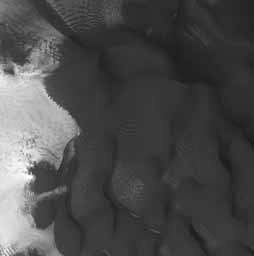
Figure 1
Click on image for larger versionThe bottom half of this HiRISE image shows a portion of a frost patch on a mound inside a northern hemisphere crater. This is the same frosted mound shown in PSP_001370_2505. The frost patch has remained largely stable at least since the Viking era (late 1970s). The bright frost region is bounded by a dune field on the northeast. Several sizes of dunes are visible. The size classes probably represent generations of dunes that formed under a variety of dominant wind conditions.
The subimage (figure 1) shows the dunes and frost boundary up-close. The frost is largely absent over the dunes, and is more stable over the ground that does not have dune-shaped landforms.
Observation Geometry
Image PSP_001700_2505 was taken by the High Resolution Imaging Science Experiment (HiRISE) camera onboard the Mars Reconnaissance Orbiter spacecraft on 06-Dec-2006. The complete image is centered at 70.4 degrees latitude, 103.4 degrees East longitude. The range to the target site was 317.5 km (198.4 miles). At this distance the image scale is 63.5 cm/pixel (with 2 x 2 binning) so objects ~191 cm across are resolved. The image shown here has been map-projected to 50 cm/pixel . The image was taken at a local Mars time of 03:14 PM and the scene is illuminated from the west with a solar incidence angle of 64 degrees, thus the sun was about 26 degrees above the horizon. At a solar longitude of 146.4 degrees, the season on Mars is Northern Summer.
NASA's Jet Propulsion Laboratory, a division of the California Institute of Technology in Pasadena, manages the Mars Reconnaissance Orbiter for NASA's Science Mission Directorate, Washington. Lockheed Martin Space Systems, Denver, is the prime contractor for the project and built the spacecraft. The High Resolution Imaging Science Experiment is operated by the University of Arizona, Tucson, and the instrument was built by Ball Aerospace and Technology Corp., Boulder, Colo.

